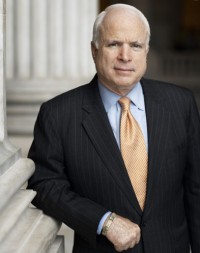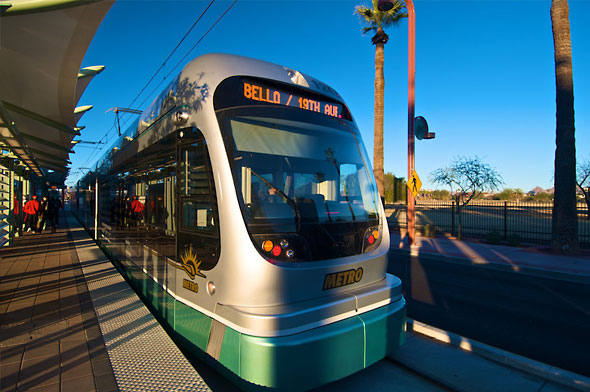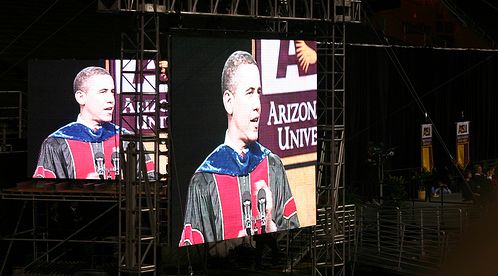Arizona
-
John McCain (R-Ariz.)
John McCain Sen. John McCain was, of course, one of the earliest congressional supporters of cap-and-trade, cosponsoring the first two pieces of climate legislation to come to the floor of the Senate in 2003 and 2005. During his campaign for president last year, he regularly touted his support for climate action. But McCain did not […]
-
Recipe for green jobs
In this economy, every state wants jobs. Green jobs are popular, but frankly, they’ll take them in any color. A great way to attract renewable energy jobs to a state is to—and this should be obvious—establish a local market. If a state provides incentives for a local solar market, for example, you get on the […]
-
GOP: Solar powered jobs can go to hell (or at least limbo)
The clock was ticking … till it stopped.Courtesy Osha DavidsonJust ten days ago, Arizona state Senator Barbara Leff (R-Paradise Valley) stood before a House committee, making the case for a bill she had written. “The Quality Jobs Through Renewable Energy Bill,” was needed, she said, to make Arizona the leader in solar [power].” Not just […]
-
Phoenix’s light rail project sparks journalism start-up
The following post was written by Michael Andersen of the Nieman Journalism Lab blog. When Adam Klawonn quit his job at a shrinking major metropolitan newspaper in 2006, he did what so many other journalists have: launched an online news operation that looked a lot like a newspaper’s web site, only with less stuff. On […]
-
Lockheed-Martin to build large CSP plant with thermal storage in Arizona
What is the best evidence that concentrated solar thermal power (CSP) aka solar baseload is indeed a core climate solution with big near-term — and very big medium-term — promise? One of the country’s biggest companies, Lockheed-Martin, with 2008 sales of $42.7 billion, has jumped into the race to build the biggest CSP plant with […]
-
Obama addresses sustainability grads and others at Arizona State
Not everyone had a close-up viewdr. coop via FlickrOn Wednesday night, President Barack Obama gave a commencement address to graduates of Arizona State University, the first school in the nation to offer degrees from a dedicated sustainability program. One student from the School of Sustainability graduated last fall, but the first real class of 13 […]
-
15 green-leaning mayors
Climate change is a global problem — but as of yet, there’s no global solution. That’s why mayors across the U.S. are taking action, from building green to organizing bike rides, from redeveloping downtowns to cutting emissions. Here are just a few of the municipal leaders who have worked to take our collective future into […]
-
Power Past Coal communities host anti-coal events during first 100 days of Obama administration
Appalachia needs no defense: It needs more defenders.
Check out the footage of the bright blast that greeted Bo Webb, a decorated Vietnam veteran, and his community last night and today in Clay's Branch, Peachtree, W. Va. A shower of rock dust mixed with a toxic brew of diesel fuel and ammonium nitrate explosives swept down their hollow, as the Richmond-based Massey Energy behemoth detonated another round of explosives in their haste to bring down the mountain for a thin seam of coal. Nearby, children attended the Marsh Fork Elementary School, the blasting in the distance like a harbinger of Massey's brutal force -- the company is now infamously embroiled in a U.S. Supreme Court case for compromising judicial neutrality in their efforts to contribute their way into the good graces of West Virginia judges -- as 2.8 billion gallons of coal sludge held back by a 385-foot-high earthen dam hover a few football fields above the school like an accident waiting to happen.
Good morning, Appalachia!
Just another day of mountaintop removal; that process of wiping out America's natural landmarks, dumping the waste into waterways and valleys, and effectively removing historic communities from their homeplaces through a campaign of horrific blasting, dusting, poisoning, and harassment.
We've reached a new landmark in the central Appalachian coalfields of West Virginia, Kentucky, Tennessee, and southwest Virginia: Over 500 mountains in one of the most diverse forests in the Americas -- the same kind of mountains that garner protection and preservation status in a blink of an eye in other regions -- -have now been eliminated from our American maps.
Five hundred mountains are gone. For what? Less than 5 percent of our nation's supply of coal, while 50 million tons of West Virginia coal are annually exported to CO2-spewing plants in countries like China.
As a new report [PDF] by Quentin Gee, Nicholas Allen and their colleagues at the Associated Students Environmental Affairs Board of UC Santa Barbara recently found, the overlooked external costs of coal further debunk the black diamond's image as a "clean" and "cheap" source of energy.
Gee and Allen write:
-
Phoenix: What happens when a city built on growth begins to shrink?
During a session called "Sustainability and Growth: How Can a City Develop Sustainably When its Identity is Built on Growth?" at the American Meteorological Society convention, a development expert named Grady Grammage colorfully dispelled some myths and revealed some little-known truths about Phoenix.
One myth: Phoenix is unsustainable because it imports water. Virtually all cities import water, Grammage pointed out, even New York, not to mention countless other necessities for urban life, such as food, fuel, and steel. Phoenix arguably has a more stable supply of water than numerous other cities, such as San Diego, because Phoenix imports its water from numerous sources, albeit at great distances.
In Grammage's view, a bigger question is "habitability," and he brought up the Urban Heat Island Effect, which he thinks, based on surveys, will drive more Phoenicians out of the state by 2020 than those who move in from other states. Grammage reports that when he expressed this view, various public officials and "water buffaloes" -- water experts -- in Phoenix scoffed.They think Phoenix could support as many as 10 million people -- more than twice its current population.





